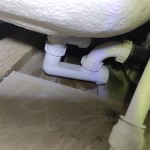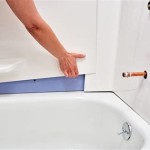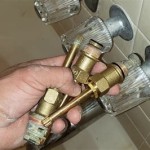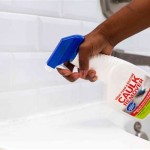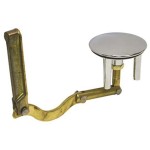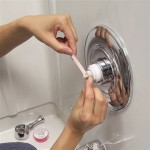Replacing Bathtub Water Knobs: A Comprehensive Guide
Replacing bathtub water knobs might seem like a daunting plumbing task, but with careful preparation, the right tools, and a systematic approach, it's a manageable project for many homeowners. This article provides a detailed guide to understanding the process, from identifying the appropriate replacement knobs to safely completing the installation.
Bathtub water knobs control the flow and temperature of water dispensed from the faucet. Over time, these knobs can deteriorate due to mineral buildup, wear and tear, or simple aesthetic preferences. Common problems include leaking, difficulty turning, or a simply outdated appearance. Replacing them can restore functionality, improve the bathroom's aesthetic, and potentially save water by addressing leaks.
Before embarking on this project, it's crucial to understand the different types of bathtub faucets and their corresponding knob attachments. This knowledge will facilitate the selection of compatible replacement knobs and ensure a successful installation. Furthermore, safety precautions must be observed throughout the process to prevent water damage and personal injury.
Identifying the Faucet Type and Knob Attachment
Bathtub faucets generally fall into a few main categories: compression, cartridge, ball, and ceramic disc. Each type utilizes a different mechanism to control water flow, and consequently, the method for attaching the knobs differs. Understanding the specific faucet type is paramount to selecting the correct replacement knobs.
Compression faucets are the oldest and simplest design. They use a rubber washer compressed against a valve seat to stop the water flow. These faucets typically have separate hot and cold water knobs, each connected to a spindle. The knobs are usually secured with a screw, either visible on the face of the knob or concealed under a decorative cap.
Cartridge faucets use a cartridge containing rubber O-rings to control water flow. The knob is attached to a stem that moves the cartridge within the faucet body. Cartridge faucets can be single-handle or two-handle designs. Replacement knobs are often secured with a setscrew on the side of the knob or with a screw hidden under a decorative cap.
Ball faucets, commonly found in kitchen sinks, employ a slotted ball to control water flow. The knob is connected to a lever arm that rotates the ball. While less common in bathtubs, some high-end installations might feature them. The knob attachment method varies depending on the specific brand and model, often involving a setscrew or a threaded connection.
Ceramic disc faucets utilize two ceramic discs with precisely placed holes to control water flow. These are considered the most durable and reliable type of faucet. The knob is attached to a stem that rotates the ceramic discs. Similar to cartridge faucets, the knobs are usually secured with a setscrew or a screw hidden beneath a decorative cap.
To identify the faucet type, examine the faucet body and the existing knobs. Look for any manufacturer markings or model numbers that can be used to research the faucet online. If the faucet is leaking, the type of leak can also provide clues. A dripping faucet is often indicative of a worn washer in a compression faucet, while a leak around the handle might suggest a worn O-ring in a cartridge or ball faucet.
Once the faucet type is identified, the next step is to determine the method of knob attachment. This involves carefully inspecting the knob for any visible screws or caps. If a screw is visible, simply removing it will usually allow the knob to be pulled off. If a cap is present, it can typically be pried off with a small flathead screwdriver, revealing the screw underneath.
Selecting the Appropriate Replacement Knobs
Choosing the correct replacement knobs is crucial for both functionality and aesthetics. The replacement knobs must be compatible with the existing faucet type and attachment method, as well as match the desired style and finish of the bathroom.
When selecting replacement knobs, consider the material. Common materials include metal (such as chrome, brass, or nickel), acrylic, and porcelain. Metal knobs are durable and offer a classic look, while acrylic knobs are often more affordable and come in a wider range of colors. Porcelain knobs provide a vintage aesthetic and can be a good choice for older bathrooms.
Ensure the replacement knobs are compatible with the faucet stem. The stem is the part of the faucet that the knob attaches to. The shape and size of the stem can vary depending on the faucet type and manufacturer. Some replacement knobs come with adapters to fit different stem sizes, but it's best to choose knobs that are specifically designed for the faucet.
Consider the desired aesthetic of the bathroom. Replacement knobs are available in a wide range of styles, from traditional to modern. Choose knobs that complement the existing bathroom fixtures and décor. If the bathroom has chrome fixtures, chrome knobs would be a natural choice. If the bathroom has brushed nickel fixtures, brushed nickel knobs would be a better fit.
It's advisable to purchase replacement knobs from a reputable plumbing supply store or online retailer. This will ensure that the knobs are of good quality and that they come with a warranty. It also allows for the option of returning the knobs if they are not compatible or do not meet expectations.
Before purchasing replacement knobs, it's also a good idea to take measurements of the existing knobs. This will help to ensure that the replacement knobs are the same size and shape. If possible, take one of the existing knobs to the plumbing supply store to compare it to the replacement options.
Step-by-Step Installation Process
The installation process for replacing bathtub water knobs can vary slightly depending on the faucet type and knob attachment method. However, the following steps provide a general guide that can be adapted to most situations.
1. Gather the necessary tools and materials:
This includes the replacement knobs, a flathead screwdriver, a Phillips head screwdriver, an adjustable wrench, penetrating oil (if needed), and plumber's putty (optional).2. Turn off the water supply:
Locate the shut-off valves for the hot and cold water lines that supply the bathtub faucet. These valves are typically located under the sink or in a nearby access panel. Turn both valves clockwise to shut off the water supply. After turning off the water supply, turn on the bathtub faucet to relieve any remaining pressure in the lines.3. Remove the existing knobs:
Depending on the knob attachment method, this may involve removing a screw from the face of the knob, prying off a decorative cap to access a screw, or loosening a setscrew on the side of the knob. If the knob is stuck, apply penetrating oil to the stem and let it sit for a few minutes before attempting to remove the knob again. Gently wiggle the knob back and forth while pulling it outwards to loosen it.4. Clean the faucet stem:
Once the old knob is removed, clean the faucet stem with a damp cloth. Remove any mineral buildup or corrosion that may be present. If necessary, use a wire brush to remove stubborn deposits. Inspect the faucet stem for any signs of damage, such as cracks or corrosion. If the stem is damaged, it may need to be replaced.5. Install the new knobs:
Align the new knob with the faucet stem and push it into place. If the knob is secured with a screw, tighten the screw until the knob is firmly attached. If the knob is secured with a setscrew, tighten the setscrew until it is snug. Be careful not to overtighten the screw or setscrew, as this could damage the knob or the stem. If there is a gap between the knob and the faucet escutcheon (the decorative plate behind the knob), apply a small amount of plumber's putty to the gap to prevent water from leaking.6. Turn on the water supply:
Slowly turn on the shut-off valves for the hot and cold water lines. Check for any leaks around the knobs or the faucet body. If there are any leaks, tighten the screws or setscrews on the knobs. If the leaks persist, turn off the water supply and inspect the faucet for any damage or worn-out parts.7. Test the faucet:
Turn the knobs to test the water flow and temperature. Ensure that the hot and cold water are flowing properly and that the knobs are easy to turn. If the water flow is restricted, there may be debris in the faucet. Remove the aerator (the screen at the end of the faucet spout) and clean it. If the water temperature is not correct, adjust the temperature settings on the water heater.Replacing bathtub water knobs is a relatively straightforward project that can be completed by most homeowners. By following these steps and taking the necessary safety precautions, the process can be completed efficiently and effectively. A new set of knobs can revitalize the bathroom's look and improve the functionality of the bathtub faucet.

How To Replace Bathtub Faucet Knob Easy Simple

Bathroom How To Replace Old Separate Hot Cold Bathtub Knobs With Modern Option Home Improvement Stack Exchange

How To Replace Bathtub Faucet Handles

How To Replace Shower Knobs Easy Step By Guide

Replace Upgrade Your Shower And Bath Handle

Diy Bathtub Faucet Repair

How To Change A Bathtub Faucet 14 Steps With Pictures Wikihow

Fast Way To Replace Or Retrofit A Two Handle Shower System With One

How To Replace Shower Faucet Trim

Repairing A Leaky Two Three Handle Tub Shower Faucet
Related Posts

